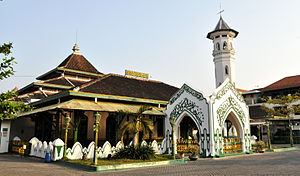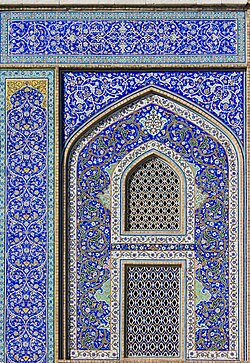
Islamic architecture comprises the architectural styles of buildings associated with Islam. It encompasses both secular and religious styles from the early history of Islam to the present day. The Islamic world encompasses a wide geographic area historically ranging from western Africa and Europe to eastern Asia. Certain commonalities are shared by Islamic architectural styles across all these regions, but over time different regions developed their own styles according to local materials and techniques, local dynasties and patrons, different regional centers of artistic production, and sometimes different religious affiliations.

Istiqlal Mosque in Jakarta, Indonesia is the largest mosque in Southeast Asia and the sixth largest mosque in the world in terms of worshipper capacity. Built to commemorate Indonesian independence, this national mosque of Indonesia was named "Istiqlal", an Arabic word for "independence". The mosque was opened to the public on 22 February 1978. Within Jakarta, the mosque is positioned next to Merdeka Square and the Jakarta Cathedral (Catholic) and also of the Immanuel Church (Presbyterian).

A corbel arch is an arch-like construction method that uses the architectural technique of corbeling to span a space or void in a structure, such as an entranceway in a wall or as the span of a bridge. A corbel vault uses this technique to support the superstructure of a building's roof.

Indo-Islamic architecture is the architecture of the Indian subcontinent produced by and for Islamic patrons and purposes. Despite an initial Arab presence in Sindh, the development of Indo-Islamic architecture began in earnest with the establishment of Delhi as the capital of the Ghurid dynasty in 1193. Succeeding the Ghurids was the Delhi Sultanate, a series of Central Asian dynasties that consolidated much of North India, and later the Mughal Empire by the 15th century. Both of these dynasties introduced Persianate architecture and art styles from Western Eurasia into the Indian subcontinent.

The Ganting Grand Mosque is a Sunni mosque located in Ganting, Padang, West Sumatra, Indonesia. Construction began in 1805, making it the oldest in Padang and one of the oldest in Indonesia. It is a Cultural Property of Indonesia.

Javanisation or Javanization is the process in which Javanese culture dominates, assimilates, or influences other cultures in general. The term "Javanise" means "to make or to become Javanese in form, idiom, style, or character." This domination could take place in various aspects; such as cultural, language, politics and social.
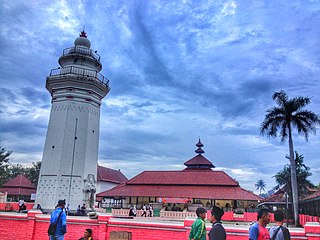
Great Mosque of Banten is a historic mosque in Old Banten, 10 km north of Serang, Indonesia. The 16th-century mosque was one of the few surviving remnants of what used to be the port city of Banten, the most prosperous trading center in the Indonesian archipelago after the fall of Demak Sultanate in mid-16th century.

The Great Mosque of Malang is a mosque located in Malang, Indonesia. The mosque was built in 1890 and was completed in 1903, making it one of the oldest mosques in Indonesia. The mosque is square-shaped, constructed with steel, and has tajug on top. The original building is still maintained until today.

Samarinda Islamic Center Mosque, also known as Baitul Muttaqien Mosque, is a mosque located in the subdistrict of Teluk Lerong Ulu, Samarinda, East Kalimantan, Indonesia, which is one of the largest mosques in Southeast Asia. It situates at the foreground of Mahakam River, and it has seven minarets and a huge dome.
Al-Akbar Mosque, also known as Great Mosque of Surabaya, is a national mosque located in Surabaya, East Java. It is the second largest mosque in Indonesia after Istiqlal Mosque in Jakarta in terms of maximum capacity. The location of the mosque is beside the Surabaya-Porong Highway Road. Its most distinctive feature is its large vertical dome, accompanied by four small blue domes. It also has a minaret with height of 99 meters, an ode to the 99 Names of Allah.

Jami Mosque of Taluak is one of the oldest mosques in Indonesia, located in Taluak IV Suku Nagari, Banuhampu District, Agam Regency, West Sumatra. The location of the mosque is close to the border of Bukittinggi, thus it is also known as Jamik Taluak Mosque Bukittinggi.
The Al-Anshor Mosque is arguably the oldest mosque in Jakarta, Indonesia. It is located at Pekojan, Tambora, Jakarta and was built in 1648.

Masjid Jami Kampung Baru Inpak, also known as Masjid Kampung Baru or Bandengan Mosque is one of the oldest mosques in Jakarta, Indonesia. It is located at Jalan Bandengan Selatan, Pekojan, Tambora, Jakarta, close to Masjid Al-Anshor. It is one of the mosques that was built by the Muslim merchants from India, who used to travel and live in Batavia. The mosque has been designated as a cultural heritage by the provincial government of DKI Jakarta.
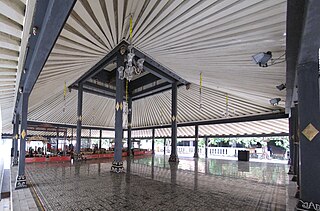
Saka guru, or soko guru in Javanese, is the four main posts which supported certain Javanese buildings, e.g. the pendopo, the house proper and the mosque. The saka guru is the most fundamental element in Javanese architecture because it supports the entire roof of the building. Because of its importance, the saka guru is imbued with symbolism and treated with certain rituals.

The Red Mosque of Panjunan is a Javanese mosque located in the village of Panjunan, Cirebon Regency, West Java, Indonesia. This 15th-century mosque with its Hindu architecture typical of Java is one of the oldest mosque in Indonesia.
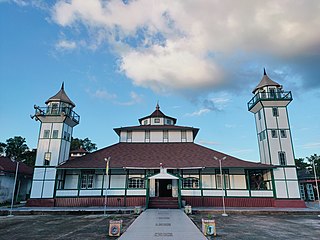
Jami Mosque of Sintang also known as Sultan Nata Mosque is a mosque located in Sintang, West Kalimantan, Indonesia. The mosque is located within the complex of Istana al-Mukarrammah, the main palace of the Sultanate of Sintang, a kingdom in Sintang which existed since the 13th-century.

Mosque architecture in Indonesia refers to the architectural traditions of mosques built in the archipelago of Indonesia. Initial forms of the mosque, for example, were predominantly built in the vernacular Indonesian architectural style mixed with Hindu, Buddhist or Chinese architectural elements, and notably didn't equip orthodox form of Islamic architectural elements such as dome and minaret. Vernacular architectural style varies depending on the island and region.

Al-Wustho Mangkunegaran Mosque is a historic mosque located in the Central Javanese city of Surakarta, to the west of the Mangkunegaran Palace. The mosque is one of the three oldest mosques of Surakarta. Al-Wustho Mangkunegaran Mosque was inaugurated as a state mosque of the Mangkunegaran Palace.
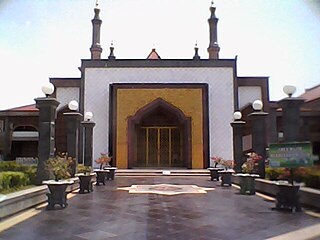
At-Taqwa Mosque or At-Taqwa Grand Mosque is a historical mosque in the city of Cirebon, West Java, founded in 1918. Today it is one of the congregational mosques in Cirebon and considered an icon of the city. The mosque also provides Islamic learning as well as public services such as blood donation and a free ambulance.
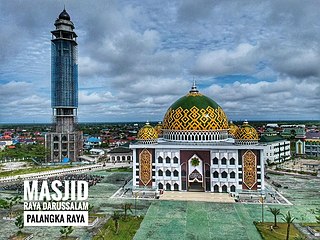
Darussalam Grand Mosque, Palangka Raya is one of the mosques in Central Kalimantan. This grand mosque is located on George Obos Street in the district of Jekan Raya, Palangka Raya. This mosque is situated within the Islamic Center area of Palangka Raya. This grand mosque is also one of the most important icons of the capital city of Central Kalimantan province.
